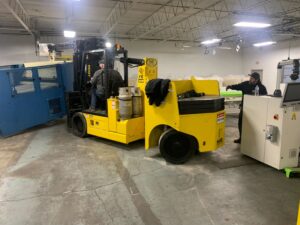Factory relocation is a complex and demanding process that requires careful planning and execution. Whether prompted by expansion, optimization, or strategic realignment, the relocation of a factory involves a multitude of moving parts and considerations. To ensure a smooth transition and minimize disruption to operations, businesses must adopt a strategic approach that prioritizes efficiency and minimizes downtime. This article aims to outline the key steps involved in strategically relocating a factory, emphasizing methods to minimize disruption and maximize efficiency throughout the process.
Assessment and Planning Phase
Before initiating the relocation process, it is imperative to conduct a comprehensive assessment of the current and future operational requirements. This assessment should include an evaluation of the existing infrastructure, machinery, workforce, and logistical considerations. Key decision-makers must also establish clear objectives and benchmarks for the relocation process, taking into account the desired outcome and anticipated challenges.
- Detailed Inventory and Asset Evaluation: Conduct a thorough inventory of all machinery, equipment, and assets within the factory. This step helps identify any obsolete or redundant equipment that may not need to be transferred to the new location, thus streamlining the relocation process and reducing unnecessary costs.
- Infrastructure and Site Evaluation: Evaluate the new site’s infrastructure to ensure it meets the operational requirements of the factory. Factors such as transportation accessibility, utility provisions, and space availability should be carefully assessed to guarantee a seamless transition to the new location.
- Risk Assessment and Contingency Planning: Anticipate potential risks and challenges that may arise during the relocation process. Develop a comprehensive contingency plan to address any unforeseen circumstances, including machinery breakdowns, delays in transportation, or unforeseen regulatory obstacles.
Logistical Preparations and Coordination
Effective coordination and logistical preparations are essential for a successful factory relocation. Seamless coordination between different departments, external vendors, and logistics partners is crucial to minimize disruption and maintain operational continuity throughout the transition.
- Clear Communication and Stakeholder Engagement: Establish transparent communication channels with all stakeholders, including employees, suppliers, and clients. Keep them informed about the relocation process, timelines, and potential impacts on operations to manage expectations and maintain trust.
- Selection of Reliable Logistics Partners: Partner with reputable logistics providers with expertise in handling industrial equipment and machinery. Ensure that the chosen partners have a proven track record of executing complex relocations efficiently and safely.
- Transportation and Equipment Handling: Develop a detailed transportation plan that outlines the logistical requirements for moving machinery and equipment to the new site. Implement stringent safety protocols to safeguard the integrity of the equipment during transit, reducing the risk of damage or malfunction.
Operational Continuity and Minimal Downtime
Maintaining operational continuity and minimizing downtime during the relocation process is crucial to prevent financial losses and preserve customer satisfaction. Implementing strategies to ensure uninterrupted production and service delivery is essential for a successful factory relocation.
- Phased Relocation Strategy: Implement a phased relocation strategy that enables the continued operation of critical production units while transferring non-essential equipment and machinery. This approach minimizes downtime and prevents a complete halt in production, allowing the business to fulfill ongoing commitments to clients and customers.
- Temporary Backup Facilities and Contingency Plans: Establish temporary backup facilities or alternative production sites to facilitate uninterrupted operations during the relocation process. These backup facilities should be equipped with the necessary infrastructure and resources to ensure a seamless transition without compromising product quality or service delivery.
- Employee Training and Support: Provide comprehensive training and support to employees to familiarize them with the new operational setup and any updated processes or machinery. Empower employees to adapt to the changes and contribute actively to maintaining productivity and efficiency during the relocation.
Post-Relocation Optimization and Performance Evaluation
Once the relocation process is complete, it is essential to focus on optimizing the new factory setup and assessing its performance against predefined benchmarks. Continuous improvement initiatives and regular performance evaluations enable businesses to identify areas for further enhancement and ensure long-term operational efficiency.
- Operational Workflow Analysis: Analyze the operational workflow in the new factory setup to identify potential bottlenecks or inefficiencies. Implement lean manufacturing principles and process optimization techniques to streamline operations and enhance overall productivity.
- Employee Feedback and Engagement: Encourage open communication and feedback from employees regarding their experiences with the new factory setup. Actively engage with the workforce to address any concerns or challenges they may be facing and foster a collaborative environment focused on continuous improvement and innovation.
- Performance Monitoring and Adaptation: Continuously monitor key performance indicators (KPIs) to assess the effectiveness of the new factory setup. Adapt the operational strategies and processes based on real-time data and insights to ensure that the factory is operating at optimal efficiency levels and meeting production targets.
Conclusion
Strategic factory relocation is a multifaceted process that requires meticulous planning, precise execution, and proactive management to minimize disruptions and maximize operational efficiency. By conducting a comprehensive assessment, implementing robust logistical preparations, ensuring operational continuity, and focusing on post-relocation optimization, businesses can successfully navigate the challenges associated with factory relocation and position themselves for sustainable growth and success in the long run. Embracing a strategic approach to factory relocation not only minimizes disruptions but also provides an opportunity for businesses to enhance their operational capabilities and remain competitive in an ever-evolving market landscape.












